Isla Vista: Investor’s Paradise
High Rents, 'Captive Demand' Make for Upscale Market in Rundown Community
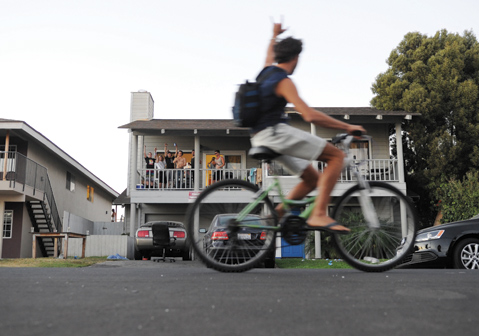
For decades, Isla Vista’s been branded a “youth ghetto,” and in some ways, the label fits. Of 15,000 residents, nearly 13,000 are students who endure urban blight, overcrowding, and a high crime rate amid a jumble of old apartment buildings and tract homes.
But the students here are not the marginalized poor. With jobs, loans, and parental support, they manage to pay Isla Vista’s high rents — $2,520 per two-bedroom apartment, on average, rooming two or more to a bedroom. In Santa Barbara, a two-bedroom apartment rents for $2,000, on average, but it’s a tight market, and the students in Isla Vista may have nowhere else to go. Investors call this “captive demand.”
Forty percent of UCSB students, some 9,300 people, live in Isla Vista, but the university owns or manages only three apartment buildings there with a total of 187 bedrooms. Santa Barbara City College, with as many as 3,500 students in Isla Vista, doesn’t own any.
“I try to tell students and parents to stay out of Isla Vista,” said Ben Partee, City College dean of educational programs. “I just don’t think it’s a healthy place. A lot of times, it’s the last choice.”
Last choice or not for students, this unincorporated community next to the beach and a prestigious university is a first choice for investors from Boston to Goleta. Even in the depths of the recession in 2010, eager buyers vied for the Tropicana Gardens, Tropicana del Norte, Tropicana Villas, Breakpointe, and Coronado apartments, some of the largest in the area.
“We liked the play in Isla Vista,” said Jessica Levin, director of acquisitions for Intercontinental Real Estate Corp., the Boston-based investment firm that purchased Breakpointe and Coronado. “There was not a lot of new construction on the horizon and the price per unit was attractive.”
As recently as this March, the Icon and Icon Gardens in downtown Isla Vista changed hands for $38.5 million, the largest real estate sale in the community in 2015 to date.
Many investors, such as Tony Romasanta of Santa Barbara, bought into Isla Vista decades ago and have never sold. Romasanta is the general partner of Islay Investments, which purchased the Garden Court apartments on El Colegio Road for $4 million in 1978. With 303 bedrooms, Garden Court is the single largest apartment complex in the community.
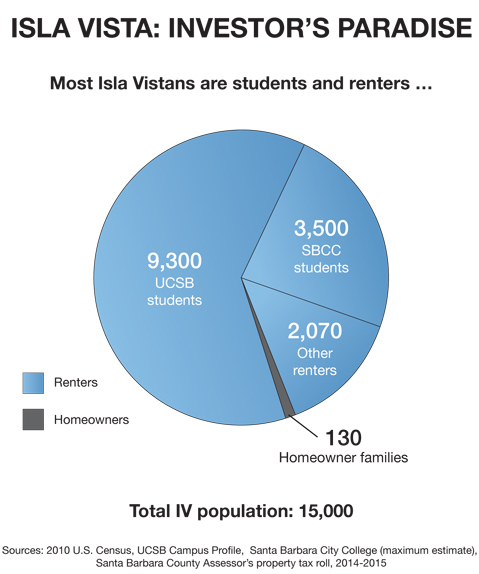
Who Owns I.V.?
A review of the 2014-2015 county property tax roll and Isla Vista Recreation and Park District bedroom tax rolls reveals that 15 entities, half of them homegrown, own a third of the community’s 8,487 bedrooms. Ranked by assessed property value, they are a mix of national real estate firms like Intercontinental that manage stock fund portfolios; “shell companies” such as Tropicana Gardens Holdings, whose ownership is cloaked under limited liability company (LLC) registration; and South Coast investors with one to 32 rental apartment buildings and a management company to boot. These local investors are Romasanta, James Gelb, Edward St. George and the Warkentin, Kitson, Harwin, and Eckert families.
Only 50 homes in Isla Vista are owner-occupied, and only a handful of rental properties are owned by Isla Vistans. About 60 percent of Isla Vista’s owner-investors live elsewhere on the South Coast.
The tax rolls don’t tell the whole story: Under Proposition 13, property assessments do not necessarily reflect market value. And the owners of about 10 percent of Isla Vista’s 920 properties, including SH Icon Santa Barbara LLC, are hidden behind shell companies.
One of the largest investors in Isla Vista is Harrison Street Real Estate Capital, a Chicago-based company that targets acquisitions near large state schools with a growing enrollment base. The company bid on some of the Tropicana apartments in 2010 but “couldn’t get there on the pricing,” said Joey Lansing, a principal in the firm. In 2013, Harrison Street purchased The Loop, a modern building on Trigo Road with three retail spaces and furnished apartments that rent for as much as $1,545 per bed per month. The Loop is assessed at $29 million.
“It’s a stable investment play,” Lansing said. “We felt confident we could keep it 98 percent occupied, and the benefit of being so close to the ocean was unique. That made it particularly attractive.”
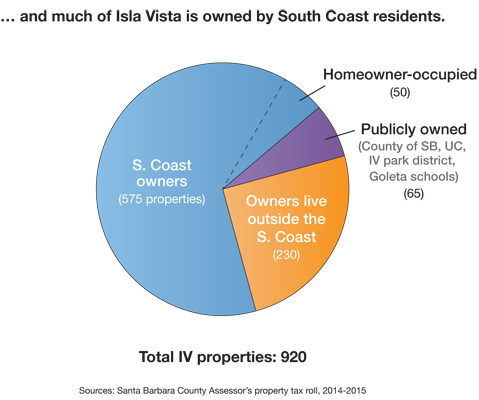
It’s not easy to be an Isla Vista landlord, though. According to Hilary Harwin, the owner of Harwin & Co., a property management firm, “There is quite a struggle to make sure the tenants are happy.” The Harwins — Hilary’s uncle Ed and her cousin, the late Howard Harwin — started building apartments in Isla Vista more than 30 years ago. The Harwins own 19 rental properties there today.
“We automatically get a bad reputation because of the way the students think,” Hilary Harwin said. “It’s a stereotype. I work hard to offer good management service and respect the fact that they pay high rents.”
The age of Isla Vista property means constant upgrades are needed, too. Mark Weinstein, a UCSB graduate who is president of MJW Investments Inc., the Santa Monica real estate company that owns the Capri Apartments on Seville and Abrego roads, said, “The only negative is that the building stock is older, and you need to spend a lot of money that you’re not going to get a return on.” Weinstein said his firm has remodeled the entire interior of the apartments, installed security gates, re-roofed the buildings and put in new plumbing.
The Capri Apartments at 6598 Seville were the site of three of the six student murders in Isla Vista on May 23 last year, and the parents are suing the owners and managers for alleged negligence. Weinstein declined to comment on the lawsuit, but of the tragedy, he said, “I can’t describe how heartbreaking it was. It’s beyond words. I went to school there and it’s hard for me to understand how things like that happen in I.V.”
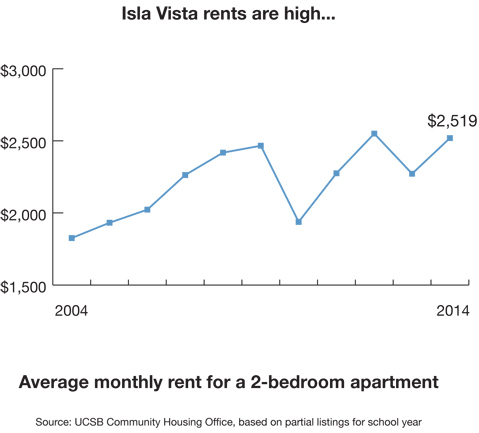
Subsidizing I.V.
While investors have prospered, Isla Vista has not. Sidewalks are missing on many streets, and the backlog to build them is $3 million — on top of a $700,000 backlog for drainage improvements and $560,000 for roads, county officials say. Parking is scarce, and it is not uncommon to see more than a dozen cars parked in an apartment’s driveway. On weekends, a heavy law enforcement presence is required to keep the partying crowds in check.
According to a 2014 report for the UCSB Foundation Board of Trustees, the annual tax revenues from Isla Vista — $5.6 million in property, sales, and bed taxes — cover less than half the cost of county services. The county spends an estimated $14.4 million yearly on fire, public works, law enforcement, courts, and planning in Isla Vista. Taxpayers outside the community are making up the $8.8 million difference.
The tax rolls suggest one reason for the shortfall. The median assessed property value in Isla Vista is only $410,000, a sign that, like Romasanta, many current owners bought years ago. Under 1978’s Proposition 13, property values were rolled back to 1976 levels, and increases cannot exceed 2 percent per year. A property is not reassessed at market value until it is sold. That’s why, this fiscal year, Romasanta and Islay Investments paid $74,000 in basic property taxes for Garden Court, while the new owners of Tropicana Gardens, a smaller apartment complex, paid $694,000.
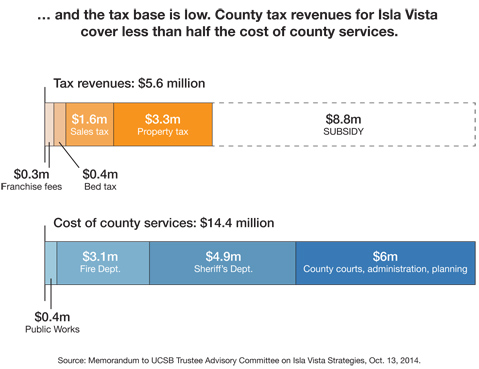
Taxes aside, several of the largest 15 owners in Isla Vista have made generous gifts of their time and money to the South Coast public. The Warkentins donated $500,000 for a synthetic turf field at the San Marcos High School stadium. The late Jerry Harwin founded Elings Park in Santa Barbara. St. George built a family and youth center at Estero Park in Isla Vista.
But other large property owners may be contributing to Isla Vista’s problems. The Isla Vista Foot Patrol, a substation of the county Sheriff’s Office, views The Sweeps at 775 Camino del Sur and The Tahitian and CBC (Colonial, Balboa, and Cortez) apartments in the 6700 block of El Colegio Road as “nuisance properties.” Each of these three complexes generates at least 100 patrol calls yearly in response to fights and loud parties, said Lieutenant Rob Plastino, who heads the Foot Patrol.
The Sweeps and CBC are owned by Essex Property Trust Inc., a $14 billion Palo Alto-based real estate investment trust that is big enough to be part of the S&P 500. The Tahitian is owned by Capitoline Properties LLC of Santa Barbara. Representatives for both firms say they have taken steps to provide good security.
“We have strengthened our code of conduct expectations for our residents and their guests, increased courtesy patrol service, and are in the process of reviewing property access controls,” said Barb Pak, an Essex vice president.
Jared Filippone, a Capitoline vice president, said, “We will continue to do our part to ensure we are providing a safe community for our tenants.”
But Sheriff’s Deputy Kim Fryslie, who’s personally made dozens of late-night visits to The Sweeps, CBC, and The Tahitian, said, “They want to manage their apartments on the backs of county taxpayers by having law enforcement take care of it. It’s a form of corporate welfare. They need to evict people.”


